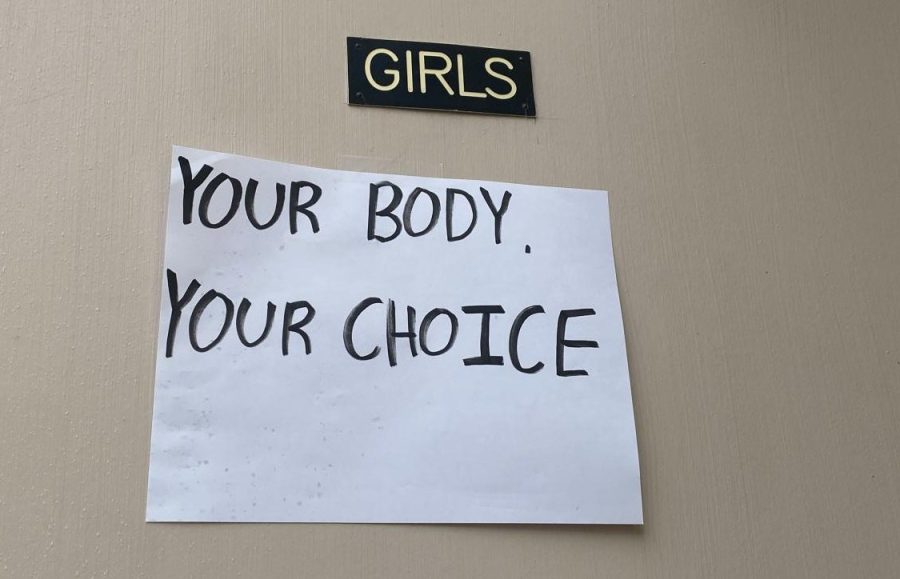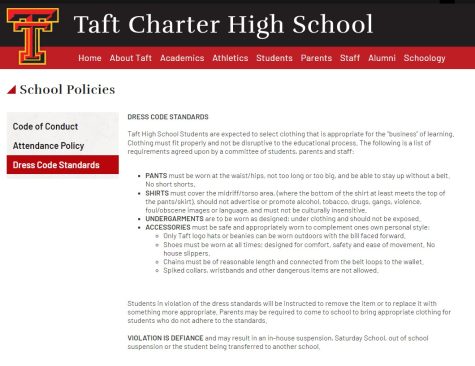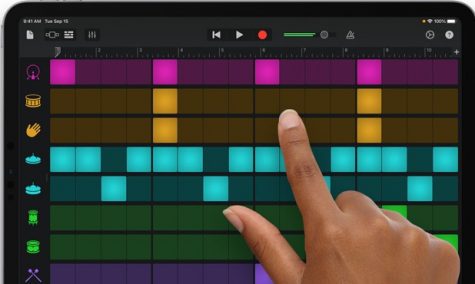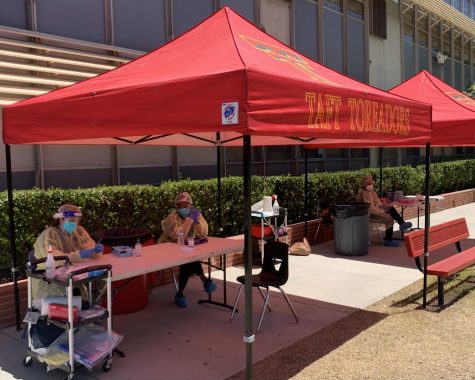The Dress Code Needs an Update!
Why the Dress Code is Sexist and Emotionally Damaging
A recreation of one of the notes posted to girls’ bathrooms around Taft campus.
Since 2009, student feel that Taft High School’s dress code has been used against its students by administrators and teachers to shame students, primarily females, for showing midriffs and shoulders in 90+ degree heat. Taft is an indoor-outdoor high school in California. When students are dress-coded, a disturbing number shared receiving negative comments such as “embarrassing”, “horrible”, “shameful”, “inappropriate” and “distracting” – amongst others. Students will be stopped in their free time, passing the halls, even in the middle of class to be demeaned in front of their peers. This is emotionally damaging, obstructive to education for both teachers and students, and not to mention, sexist.
“I believe it interrupts everyone’s education, especially females, being called out of class is an issue. It interrupts our education.”
— Female Taft Student
Most dress-coded students are women; this is an alarming fact in just one school in the LAUSD.
Many students see clear evidence of gender bias, ““When they were announcing the fund raiser for shirts to dress code girls, they specifically said young girls in front of the sentence and that just proves they target us. The fact that they’re focusing on fundraisers that try to cover us up instead of things that matter like better lunches is unbelievable.”
The bias also extends to who teachers target with their policies, as one student shared: “I was once sitting with one of my guy friends and that day he was wearing a crop top. When I lifted my arms to stretch, only a little bit of my midriff showed and a teacher came up to me and said, ‘What are you doing, why would you show off your stomach like that, you need to go to the office right now and change.’ I ended up missing my whole 5th period class because they called my parents.”
The Dress Code should promote being comfortable and being able to express yourself in a school setting; this is our first amendment right. The way we express ourselves through speech, which includes how we dress to represent ourselves through fashion, is not only a privilege but a constitutional right. This also violates the 4th amendment which states that no US citizen shall be deprived of privileges, within its jurisdiction, the equal protection of the laws. This means equal protection for both men and women, regardless of age.
“It’s unfair for a person to be punished because of another person’s actions when they have nothing to do with it.”
— Male Taft Student
Beyond concerns about gender bias, Taft students are concerned that the dress code reveals a racial prejudice. One Taft student noted, “I don’t think the dress code is only sexist, but also racist. One day I decided to wear a belt in a certain style and there is a stereotype mainly towards Mexicans that it means they’re in a gang. I was dress coded and reprimanded for it and for my culture.” -Anonymous Taft Student.
The LAUSD dress code should be more modern and up-to-date than one written by an elderly man 12 years ago; one that is viable and changes with the generations today and the ones following.
For several years women have fought for the right to work, vote, divorce, be independent, and express themselves. Even in 2021, young girls in school are being subjected to a sexist dress code that undermines their self-image in the eyes of others and of themselves. This is abundantly clear in Taft. Young women are treated as if they have committed a crime by wearing clothes that reveal even the slightest amount of skin. The LAUSD Dress Code sexualizes young girls’ bodies by implying that any skin is an inappropriate sexual object that must be covered.
“When they were announcing the fund raiser for shirts to dress code girls, they specifically said young girls in front of the sentence and that just proves they target us. The fact that they’re focusing on fundraisers that try to cover us up instead of things that matter like better lunches is unbelievable.”
— Female Taft Student
This thinking not only enables toxic masculinity, it portrays boys as nothing more than sexual creatures who are unable to control themselves.
A male student expressed that the dress code demeans men too, explaining, “We’re not animals, no stomach or shoulders are going to provoke us. Men can control themselves and the ones that can’t, they’re in the wrong, not the girl. So it’s dumb that girls are the ones being policed at school.”
Another student reinforced this notion, “As a man, I can control myself and when girls get dress-coded, it doesn’t help me from getting distracted but it does affect them and that’s a big problem.”
“I think it’s really dumb that shoulders and stomachs are to be considered provoking or sexual, it doesn’t make sense and it makes the dress code really strict. Nobody likes it.”
— Male Taft Student
One male student questioned young women being punished for these concerns about male students, “It’s unfair for a person to be punished because of another person’s actions when they have nothing to do with it.”
Most girls will wear more revealing clothing during the summer to allow themselves to breathe on 100+ degree days, but LAUSD expects them to cover their full body and sweat in the heat.
Comfortable clothing and individual confidence in the wearer promotes a healthy learning environment advocating for equality and acceptance. The ability to be cool regardless of showing the body you were born with is more important than ‘protecting the aggressors from distraction’.
An anonymous female who attends Taft said about the Dress Code, “I think it’s objectifying women, I’ve noticed rather that it’s not the guys looking at us, it’s rather the teachers and the ones who dress code us. We’re not trying to make ourselves noticeable, we’re just wearing what we want and apparently the teachers find that as an offensive thing, and they’re the only ones looking.”
After a survey of 90 interviews including, males, females, and teachers, 87.75% said that the dress code is unfair.
“As a man, I can control myself and when girls get dress-coded, it doesn’t help me from getting distracted but it does affect them and that’s a big problem.” -Male Taft Student.
It targets women, is sexist, and needs a modern update. An overwhelming amount of females feel shamed by their own administrators or are hesitant to wear what they feel confident in out of fear of being shamed by those same administrators and teachers.
“One time I was walking out of school to the parking lot to leave, and I’m part of the dance team so I only had my sports bra on. One of the administrators came up to me and started yelling at me saying, ‘How could you wear that, you should feel embarrassed right now, what if someone sees you dressed like this?’ When I tried standing up for myself she was saying I’m only talking back and being disrespectful and literally the boys track team ran by, all shirtless and she didn’t say anything.”
— Female Taft Student
“When I get dress coded, I feel attacked, sexually harassed, and the people who dress coding me make me feel like my body is an issue,” explained one female Taft Student. Comments like this are highly concerning and it also should raise alarm that Taft is more preoccupied with the staff they hired not being able to focus, due to the bodies of minors, than they are with the students they’re leading, who are the future.
It also raises concern about the Taft staff’s objectification of female students.
One student questioned, “They’re saying that the staff are getting distracted and that seems pretty weird to me because why would you hire them if they were just going to sexualize girls?”
On the other hand, dress codes can be helpful and useful in situations that are gang related, highly offensive or detrimental to specific groups of students. These are reasonable expectations to ensure the safety, well being, and learning capacity of all students and staff. Should students be allowed to go to school wearing only their undergarments, bottoms, or chests exposed? No! No student should be allowed to come to school exposed.
If we speak of equality, nobody should be able to undress at school regardless of how you identify with gender. It is reasonable to expect that our clothing does not promote homophobia, sexism, racism, or violence. When a student is dress-coded, there should be clear boundaries as well. Administrators and teachers should not be allowed to use negative language and should not have the goal of embarrassing the dress-coded student. There can be a healthy relationship with dress-coding rather than one that makes Taft students feel targeted and uncared for. All schools should want their students’ voices to be heard because they will matter more than anything else one day.
“For women, I think the dress code is pretty wrong and they need to fix it because it’s pretty weird that you can’t show any stomach at all. There is nothing you can do to control how your body looks so are teachers trying to restrict that? Why would you take away their choice like that because of what they’re born with?”
— Male Taft Student
The dress code doesn’t need to be completely abolished, it just needs a modern update that focuses on everyone’s comfort.
My name is Selah Orion and most of you know me for my bright pink hair! This year I found out that I'm a passionate writer...












